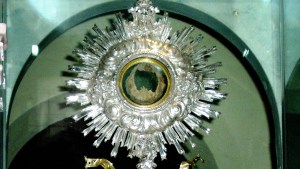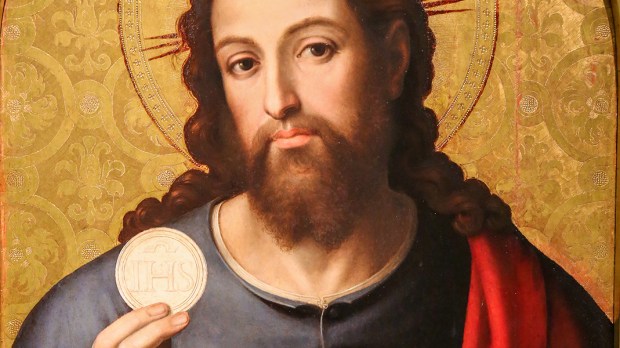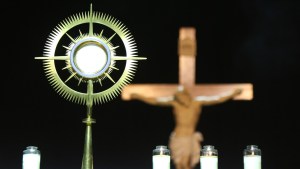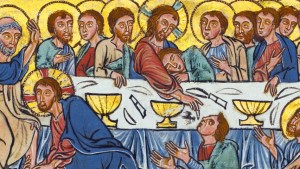The Eucharist is a central teaching of the Catholic Church that is today often misunderstood.
While it is easy to see how the Eucharist might symbolically represent Jesus’ Last Supper with his apostles, it isn’t always clear that Catholics believe Jesus is present in a unique way.
For Catholics, the Eucharist is not merely a symbol, but Jesus Christ himself.
Here is a brief summary of 4 fascinating facts about the Eucharist. You can click on the links to learn more about them.
Jesus is truly present, body, blood, soul and divinity
The Catholic Church teaches a dogma called “transubstantiation,” which the Catechism explains thus: “By the consecration of the bread and wine there takes place a change of the whole substance of the bread into the substance of the body of Christ our Lord and of the whole substance of the wine into the substance of his blood” (CCC 1376).
This means that while the appearances of bread and wine remain, the substance is changed (through the power of God) completely to the body and blood of Christ. It is a teaching based on Scripture and tradition and has remained unchanged in its essence since Apostolic times.
Demons believe and tremble before the Real Presence
A spokesman from the satanic group, Adam Daniels, said, “The whole basis of the [satanic] ‘mass‘ is that we take the consecrated host and give it a ‘blessing‘ or offering to Satan. We’re censoring it, [I think he means using incense], doing all things that’s [sic] normally done to bless a sacrifice, which is obviously the host body of Christ. Then we’re taking that and we’re reconsecrating it, or the Devil does …” [The bracketed comment and the single quotation marks within the above quote are mine.]
In light of the threatened lawsuit, the group returned the consecrated host to the Church. Thanks be to God.
But did you notice the satanic spokesman’s attestation regarding the host: “which is obviously the host body of Christ”?
Grave and sad though this incident was (and it wasn’t the first), these Satanists obviously consider the Catholic Eucharist to be the actual Body of Christ, not a symbol of him. Here then is an affirmation of the Scripture that says, Even the demons believe—and shudder (James 2:19).
Scripture is clear about what the Eucharist is
Several passages from the New Testament show where this teaching finds its primary source. A more lengthy discussion of the sacrament of the Eucharist can be found in the Catechism of the Catholic Church.
The strongest reference comes from Jesus himself in JOHN 6:54-57.
Here Jesus says:
Whoever eats my flesh and drinks my blood has eternal life, and I will raise him on the last day. For my flesh is true food, and my blood is true drink. Whoever eats my flesh and drinks my blood remains in me and I in him. Just as the living Father sent me and I have life because of the Father, so also the one who feeds on me will have life because of me.
In the following verses we see that this teaching was scandalous from the very first moment. Several of Jesus’ followers abandon him after this, but he doesn’t walk back his words to get them back. The Eucharist is what Christ wants for his Church, because he wants to be truly with us in our pilgrimage on earth.
We know early Christians believed the Eucharist was Jesus’ body and blood, not just a symbol
“I have no taste for the food that perishes nor for the pleasures of this life. I want the Bread of God which is the Flesh of Christ, who was the seed of David; and for drink I desire His Blood which is love that cannot be destroyed.” (St. Ignatius of Antioch – 1st century)
“This food we call the Eucharist, of which no one is allowed to partake except one who believes that the things we teach are true, and has received the washing for forgiveness of sins and for rebirth, and who lives as Christ handed down to us. For we do not receive these things as common bread or common drink; but as Jesus Christ our Savior being incarnate by God’s Word took flesh and blood for our salvation, so also we have been taught that the food consecrated by the Word of prayer which comes from him, from which our flesh and blood are nourished by transformation, is the flesh and blood of that incarnate Jesus.” (St. Justin Martyr – 2nd century)
“[Christ] has declared the cup, a part of creation, to be his own Blood, from which he causes our blood to flow; and the bread, a part of creation, he has established as his own Body, from which he gives increase to our bodies.” (St. Irenaeus of Lyons – 2nd century)
The Church consistently teaches this truth, though especially since the Protestant Reformation there has been much confusion.
To this day, most Christians worldwide believe in the Real Presence of Jesus in the Eucharist.
There are a little more than 2 billion Christians in the world. Half of those, about 1 billion, are Catholics (of those, only 7% are in the United States). Another 12% of the world’s Christians are Orthodox Christians who also believe in the Real Presence.
That means more than 3 of every 5 Christians belongs to a Church that believes in the Real Presence.
It’s no wonder. When Jesus says we are saved by his blood, he doesn’t mean that we are “saved” by his “blood” — he means his real blood really gives us eternal life.
See more articles here.
Sometimes, God wants us to see it with our eyes!
These miracles are a living testament to the Catholic Church’s teaching that while the appearances of bread and wine remain, the substance is changed (through the power of God) completely to the body and blood of Jesus Christ. It is a teaching based on Scripture and tradition and has remained unchanged in its essence since apostolic times.
Additionally, the Church has recognized that on occasion God intervenes in a more visible way and can change even the appearances of the bread and wine into the visible form of body and blood. Or God may miraculously preserve a consecrated host for an extended amount of time, past what is natural for bread (as may be the case with the possible miracle in Italy).

Read more:
4 Incredible Eucharistic miracles that defy scientific explanation



